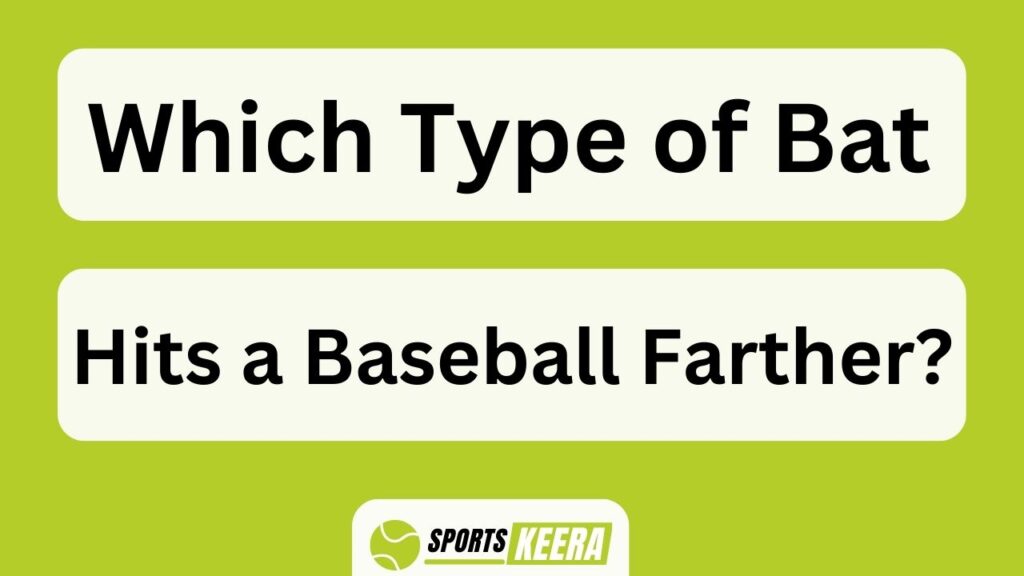In the world of baseball, where every swing can make or break a game, one question looms large: Which type of bat hits a baseball farther? Like two opposing forces on the field, wooden and metal bats have long battled for dominance. Each possesses its own unique characteristics and advantages that can drastically impact ball speed and distance.
Picture this: A batter steps up to the plate, gripping their weapon of choice with unwavering determination. Will they choose the traditional elegance of a wooden bat or opt for the modern power of a metal one? This article aims to shed light on this age-old debate through an objective, analytical lens.
By comparing performance in different leagues and delving into player preferences, personal comfort, technology advancements, and historical evolution of baseball bats, we will uncover the secrets behind hitting that elusive home run. Through real-life examples and case studies, we will explore how skill and technique come into play in determining which type of bat reigns supreme.
So join us as we embark on this journey into the realm of baseball bats – where science meets artistry – to finally discover which type hits a baseball farther.
Key Takeaways Which Type Of Bat Hits A Baseball Farther?
- Metal bats provide higher elasticity and greater energy transfer, resulting in faster ball speeds and longer distances compared to wooden bats.
- The choice of bat greatly impacts the distance a hit can travel.
- Technological advancements in bat design have revolutionized the game of baseball, allowing players to generate more power and hit the ball farther.
- Proper technique and skill play a crucial role in hitting a baseball farther, regardless of the type of bat used.
The Difference Between Wooden and Metal Bats
There’s a clear distinction between wooden and metal bats when it comes to hitting a baseball farther. Ballistics analysis reveals that the construction of the bat plays a crucial role in determining its performance.
Wooden bats are typically made from ash or maple, offering less trampoline effect upon contact with the ball. This limitation results in lower ball speed and shorter distances.
On the other hand, metal bats are constructed with materials such as aluminum or composite alloys, providing higher elasticity and greater energy transfer upon impact. As a result, they generate faster ball speeds and longer distances compared to wooden bats.
Understanding this difference in bat construction is essential for players seeking maximum performance on the field. Transitioning into the next section about ‘the impact on ball speed and distance,’ it becomes evident that choosing the right type of bat can significantly affect one’s overall game.
The Impact on Ball Speed and Distance
Imagine swinging a bat with all your strength, feeling the sheer power and velocity as the ball soars through the air, defying gravity with every inch it travels. When it comes to hitting a baseball farther, the type of bat used can have a significant impact on ball speed and distance.
The materials and construction of wooden and metal bats affect their performance in different ways. A metal bat’s lightweight design allows for faster swing speeds, resulting in increased ball speed off the bat. On the other hand, wooden bats provide less trampoline effect but require more precise swing mechanics to generate power. These differences in ball speed and swing mechanics ultimately determine how far a hit will travel.
Moving forward into comparing performance in different leagues, it becomes evident that bat choice plays a crucial role in achieving optimal results without compromising game regulations or player safety.
Comparing Performance in Different Leagues
When comparing performance in different leagues, it’s clear that the choice of bat greatly impacts the distance a hit can travel. In Major League Baseball (MLB), where players earn substantial salaries, they have access to top-of-the-line equipment that maximizes their hitting potential.
On the other hand, in lower-tier leagues or amateur leagues, players often have limited resources and may use bats of lesser quality. This disparity in bat quality directly affects the distance a hit can travel.
It’s worth noting that fan preferences also come into play. Fans expect to see impressive home runs and long hits, so professional players are under pressure to use high-performance bats to meet these expectations.
Transitioning into the next section about player preferences and personal comfort, it is important to consider how these factors influence their choice of bat without compromising performance.
Player Preferences and Personal Comfort
Player Preferences and Personal Comfort are key factors when it comes to choosing a baseball bat. Grip and Feel play a crucial role in a player’s ability to control the bat and make solid contact with the ball.
The way a bat swings and how much control a player has over it also greatly impacts their performance on the field. Additionally, confidence and mental factors come into play as players often have preferences based on their personal experiences and beliefs, which can influence their overall comfort level with a specific bat.
Grip and Feel
Contrary to popular belief, the type of bat grip and feel does play a significant role in determining how far a baseball can be hit. The choice of bat material and hand placement directly influence the player’s ability to generate power and control during their swing.
A comfortable grip allows for better bat control, allowing the batter to make solid contact with the ball. Additionally, different materials may provide varying levels of vibration dampening, affecting how much energy is transferred from the bat to the ball upon impact.
Hand placement also plays a crucial role in maximizing power. By adjusting their grip, batters can optimize their swing mechanics and generate more force when making contact with the ball. The position of their hands on the handle determines where the sweet spot of the bat aligns with their swinging motion, resulting in greater power transfer.
As we transition into discussing ‘bat swing and control,’ it is important to note that grip and feel are just one aspect of achieving optimal performance at the plate.
Bat Swing and Control
To truly maximize your performance at the plate, mastering your bat swing and control is paramount.
Bat speed plays a crucial role in hitting a baseball farther, as it allows for greater power generation. The faster the bat swings through the zone, the more force it can generate upon contact with the ball. Players who are able to maintain high bat speed throughout their swing have a higher likelihood of hitting the ball with power and distance.
In addition to bat speed, proper control over the swing is essential. A well-controlled swing ensures that the player makes solid contact with the ball consistently. It allows them to adjust their timing and angle of attack based on pitch location and type. By maintaining precise control over their swing, players can optimize their chances of making solid contact and driving the ball farther.
As we transition into discussing confidence and mental factors, it’s important to understand that both physical mechanics and mental preparedness go hand in hand when it comes to maximizing your performance at the plate.
Confidence and Mental Factors
Confidence plays a crucial role in maximizing performance at the plate, as it allows for greater mental focus and the ability to make quick decisions. When a batter is confident, they’re more likely to trust their instincts and react instinctively to pitches. This can lead to improved timing and bat speed, resulting in harder hit balls and potentially longer distances.
Mental factors such as self-belief, concentration, and a positive mindset all contribute to a player’s overall confidence levels. Additionally, previous successes and positive experiences can also boost confidence levels. However, it’s important to note that confidence alone doesn’t guarantee success; skill and technique also play significant roles in hitting a baseball farther.
Transitioning into the subsequent section about the influence of technology and innovation, advancements in equipment design and technological innovations have revolutionized the game of baseball.
The Influence of Technology and Innovation
Imagine how much farther players could hit a baseball with the latest advancements in bat technology and innovation. The influence of technology on player performance cannot be underestimated.
Over the years, bats have undergone significant changes to enhance their performance and improve players’ hitting power. From the introduction of aluminum bats to composite materials, each advancement has had a profound impact on the game. Bats are now designed with larger sweet spots, better weight distribution, and improved energy transfer capabilities. These innovations allow players to generate more power, resulting in longer hits and increased distances covered by the baseball.
However, it’s important to consider safety considerations and player protection when discussing bat innovations. Transitioning into the next section about safety will explore how these advancements have also raised concerns about pitcher safety and protective gear for players without compromising their hitting abilities.
Safety Considerations and Player Protection
When considering safety in baseball, there are several key points to discuss.
First, ball exit speed is a crucial factor in injury risk for both players on the field and spectators. It’s important to understand how different factors such as bat technology and player strength can affect ball exit speed.
Second, pitcher safety and reaction time are vital considerations. The speed at which pitchers must react to line drives coming back at them can greatly impact their safety on the field.
Finally, league rules and equipment standards play a significant role in ensuring player protection. Establishing regulations on bat materials, protective gear, and playing conditions helps minimize injury risks for all those involved in the game of baseball.
Ball Exit Speed and Injury Risk
To find out if a theory about ball exit speed and injury risk is true, you’ll need to investigate which type of bat hits a baseball farther. Ball exit speed refers to the velocity at which the ball leaves the bat upon impact. This speed is crucial in determining player safety, as higher ball exit speeds increase the risk of injuries for both pitchers and fielders. Understanding how different types of bats affect ball exit speed is essential for assessing player safety on the field.
In order to make it more enjoyable and relatable, here are four interesting facts about ball exit speed:
- A faster ball exit speed increases the chances of hitting a home run.
- Bats with larger sweet spots tend to produce higher ball exit speeds.
- The weight distribution of a bat affects its ability to generate high velocities upon impact.
- Technological advancements in bat design have led to significant improvements in ball exit speeds.
Considering these factors will not only shed light on player safety but also provide insights into maximizing offensive performance. Transitioning into the subsequent section about pitcher safety and reaction time, it becomes evident that understanding ball exit speeds is crucial for assessing overall game dynamics and potential risks involved.
Pitcher Safety and Reaction Time
Ball exit speed not only affects the injury risk for players on the field, but it also poses a potential danger to pitchers. When a baseball is hit with great force, it leaves the pitcher with very little time to react and protect themselves.
Pitcher safety is of utmost importance in the game, and their ability to respond quickly can be crucial in avoiding serious harm. The faster the ball travels off the bat, the shorter amount of time a pitcher has to defend themselves. Therefore, understanding pitcher reaction time is essential for ensuring their safety on the mound.
Moving forward, it’s important to examine league rules and equipment standards that are in place to address these concerns and provide additional protection for pitchers against hard-hit balls.
League Rules and Equipment Standards
You should be aware of the league rules and equipment standards in place to ensure pitcher safety and provide additional protection. These regulations play a crucial role in determining bat performance and ultimately, how far a baseball can be hit.
Here are three key factors to consider:
- Bat materials: The league enforces strict guidelines on bat composition. Aluminum bats, for example, are commonly used due to their lightweight nature, which allows hitters to generate more bat speed and power.
- Bat size: Regulations also dictate the maximum length and diameter of a bat. This ensures that players don’t use excessively long or wide bats, which could give them an unfair advantage.
- Bat testing: To maintain fairness, the league regularly tests bats for compliance with its standards. This helps prevent the use of altered or illegal bats that could significantly impact hitting distance.
Understanding these equipment regulations is essential when evaluating how different types of bats can affect baseball distance. Moving forward into the next section about the role of skill and technique…
The Role of Skill and Technique
With their expert swing, skilled batters unleash a hurricane of power that propels the baseball into the stratosphere, leaving spectators in awe. When it comes to hitting a baseball farther, skill and technique play a crucial role, often overshadowing pure strength and power. While raw strength can certainly contribute to distance, it is the refined technique and precise timing that allow batters to maximize their potential. By mastering the mechanics of their swing, batters are able to generate optimal bat speed and transfer energy efficiently from their body to the ball. A well-executed swing can turn even an average bat into a powerful weapon capable of launching balls deep into the outfield. As we delve into the historical evolution of baseball bats, we will explore how changes in design have further enhanced players’ ability to hit for distance without sacrificing control or accuracy.
Historical Evolution of Baseball Bats
The role of skill and technique in hitting a baseball cannot be understated. However, another factor that has significantly impacted the game is the historical evolution of baseball bats.
Over time, there have been numerous changes in bat design and materials used, leading to significant improvements in performance. From the early days when players used heavy wooden clubs to modern times with high-tech composite materials, the evolutionary changes have been remarkable.
Technological advancements have played a crucial role in this evolution. With a better understanding of physics and engineering principles, manufacturers have been able to optimize bat design for maximum power and control. These advancements have resulted in bats that are lighter yet more robust, allowing players to generate greater bat speed and hit the ball farther.
Understanding how these historical changes and technological advancements have shaped baseball bats provides valuable insights into which type of bat may hit a baseball farther. Real-life examples and case studies will further illustrate this point.
Real-life Examples and Case Studies
Notable home run hitters have played a significant role in the evolution of baseball bats. Their success at hitting home runs has often been attributed to their ability to select the right bat for their swing and playing style.
Bat selection and performance analysis have become important factors for players and teams looking to maximize offensive output. Statistical data and comparisons provide valuable insights into the effectiveness of different bat types, allowing players to make informed decisions on which bat will help them hit the ball farther.
Notable Home Run Hitters
Babe Ruth, known as the Sultan of Swat, blasted home runs like nobody else. He is undoubtedly one of the most notable sluggers in baseball history and a true power hitter. Ruth’s incredible ability to hit home runs set him apart from his contemporaries.
In examining notable home run hitters, it’s clear that certain players possess an exceptional knack for sending balls out of the park. Players like Hank Aaron, Barry Bonds, and Alex Rodriguez consistently displayed immense power at the plate throughout their careers. These sluggers could effortlessly launch baseballs into the stands with remarkable distance.
Understanding the prowess of these legendary hitters helps shed light on the importance of bat selection and performance analysis. By studying their techniques and utilizing advanced technology to analyze bat performance, players can gain valuable insights into maximizing their own hitting potential.
Transitioning into the subsequent section about ‘bat selection and performance analysis,’ it becomes evident that understanding different types of bats is crucial in determining which type hits a baseball farther.
Bat Selection and Performance Analysis
When it comes to selecting the perfect bat and analyzing its performance, players must consider various factors to maximize their hitting potential.
One crucial aspect is the comparison of different bat materials. Wood bats are known for their traditional feel and solid contact, but they may lack the power of composite or aluminum bats.
Composite bats offer a larger sweet spot and increased trampoline effect, leading to greater distance potential.
Aluminum bats, on the other hand, provide a lightweight design that allows for faster swing speeds.
To determine which type of bat hits a baseball farther, player performance analysis is essential.
By analyzing statistical data and comparing results from different players using various types of bats, one can gain valuable insights into the best bat selection for maximizing distance potential without compromising control or consistency in hitting technique.
Statistical Data and Comparisons
Comparing statistical data and player performance can provide valuable insights into maximizing hitting potential with the perfect bat. By analyzing various statistics such as batting average, slugging percentage, and home run rates, players and coaches can determine which type of bat will have the greatest impact on player performance.
Additionally, examining training methods used by successful hitters can offer further guidance in selecting the right bat.
Batting average: A higher batting average indicates consistent contact with the ball, suggesting that a certain type of bat may be more suitable for achieving this.
Slugging percentage: This statistic measures a hitter’s power and ability to hit extra-base hits. Bats that generate greater speed or have a larger sweet spot may be beneficial for increasing slugging percentage.
Home run rates: Studying how different bats contribute to home run production can help players choose one that enhances their long ball abilities.
Considering these factors, it is important to carefully analyze statistical data and training methods when determining which type of bat will optimize hitting potential. Transitioning into the subsequent section about ‘conclusion and final thoughts’, it becomes clear that making an informed decision about bat selection requires considering various factors beyond personal preference alone.
Conclusion and Final Thoughts
In conclusion, it’s important to consider that different types of bats may have varying effects on hitting distance. The material of the bat and the swing mechanics play a crucial role in determining how far a baseball can be hit.
Statistical data and comparisons have shown that certain bat materials, such as composite or aluminum alloy, tend to provide more power and generate greater ball speed compared to wooden bats. This is due to their lighter weight and ability to flex upon impact, resulting in increased energy transfer to the ball.
Additionally, swing mechanics, including the angle of attack and the speed at which the bat is swung, also contribute significantly to hitting distance. Players with proper technique can maximize their power potential regardless of the type of bat they use.
Ultimately, understanding these factors can help players make informed decisions when selecting a bat for optimal performance on the field.
Frequently Asked Questions
What is the average distance that a baseball is hit with a wooden bat compared to a metal bat?
On average, a baseball is hit farther with a metal bat compared to a wooden bat. The use of a metal bat has a significant impact on performance, resulting in increased distance.
Are there any regulations or restrictions on the type of bat that can be used in professional baseball leagues?
There are regulations and restrictions on the type of bat used in professional baseball leagues. These rules aim to ensure fair play, safety concerns, and protective measures. Both wooden and metal bats have their advantages in terms of design, performance, and innovation.
Do professional baseball players have a preference for wooden bats or metal bats?
Professional baseball players have a preference for wooden bats or metal bats. Their bat choice can impact their performance. The decision is influenced by factors such as personal preference, league regulations, and the player’s hitting style.
How has technology and innovation influenced the design and performance of baseball bats over time?
The impact of composite materials on baseball bat performance and the evolution of bat design in relation to player performance have been greatly influenced by technology and innovation over time.
Are there any safety concerns or protective measures in place for players using different types of bats?
Safety concerns and protective measures are in place for baseball players using different types of bats. These measures aim to prevent injuries and ensure player safety during games.
Conclusion
In conclusion, the type of bat that hits a baseball farther is still a subject of debate. While metal bats are known for their superior power and distance, wooden bats have their own advantages in terms of control and precision.
Ultimately, the choice between the two depends on personal preference and individual player skills. It’s important to consider factors such as league regulations, player comfort, and advancements in technology when making this decision.
Whether it’s the crack of a wooden bat or the ping of a metal one, each has its own unique charm that adds to the beauty of America’s favorite pastime.






